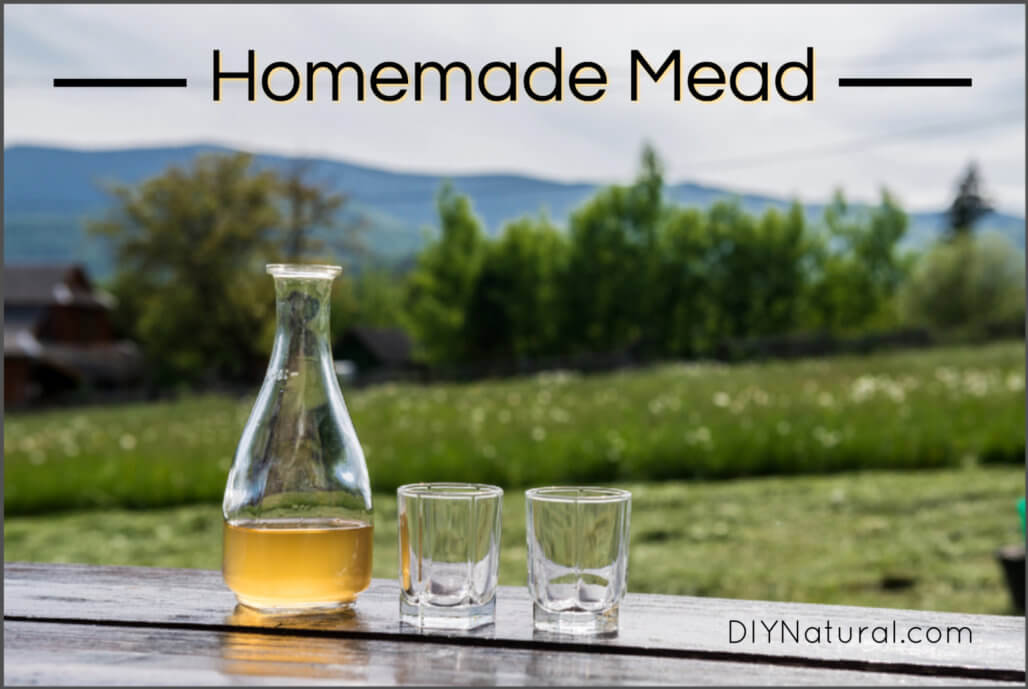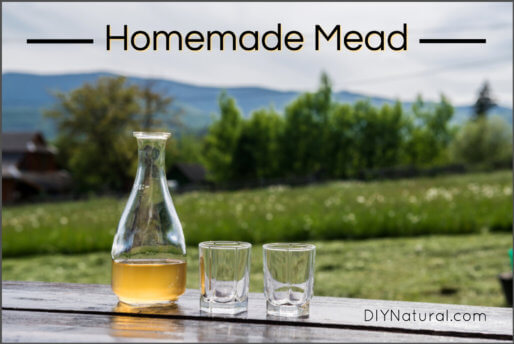
Homemade mead is a fermented beverage made from honey, water, and yeast. Our honey mead recipe can be sweet or dry and also offers flavoring suggestions.
Fall makes me think of pumpkins, apple cider, and mead! You can make mead with simply honey, water, and yeast, or you can add fruit, herbs, and even pumpkin!
What is Mead?
All homemade mead is made from a similar honey mead recipe because it is simply a fermented beverage (like beer) made from honey, water, and yeast. It is one of the oldest fermented beverages known to man.
Additions of fruit can make it sweeter or drier, depending on the amount of honey used. The type of yeast can also play a role here. When herbs are added to it it is then called a “metheglin.” No matter what you add (or don’t add), it can be produced in as little as two weeks in a very warm environment, or as much as 8 weeks in a cold room.
Are you ready to dive into this honey mead recipe? Let’s go!

How to Make Mead: A Homemade Honey Mead Recipe
Homemade mead is a fermented beverage made of honey, water, and yeast. Make our honey mead recipe sweet or dry with flavoring suggestions.
- Servings
- 1 gallon
- Course
- Beverage
- Cuisines
- American, Chinese, Greek, Indian
Equipment
Ingredients
- filtered water (or distilled)
- 2-3 pounds honey (local raw honey is best)
- 2 g champagne yeast (⅕ – ½ of a 5g package)
Instructions
-
Simmer ½ gallon of water until warm.
-
Add honey: 2 pounds for a dry mead or 3 pounds for a sweet mead. Stir until dissolved.
-
Simmer (don't boil) for about 30 minutes, skimming off any scum that forms. Remove from heat and let cool to about 100°F and pour into 1 gallon carboy.
-
Add any extra ingredients you may want. See below for ideas.
-
When the temperature is below 90°F, add the yeast. One package will make 5 gallons of mead, so use between ⅕ of a package and ½ a package. I typically make two gallons at a time and divide the package between the two.
-
Cap the bottle and shake well. Add more water to fill the bottle, making sure to leave 3-4 inches of headroom at the top. Take the top off and add an airlock. These are available at your local homebrew store or online here.
-
Once the airlock is in place, set the bottle in a cool spot for about 6 weeks.
Recipe Video
Notes
Within 12 to 24 hours, you’ll notice bubbling and foaming in the top of the bottle. This is normal. If you add fruit or herbs, this may bubble into the airlock and get stuck. This is normal too, but you’ll want to clean it out well and reset it. A clogged airlock could lead to an explosion.
After six weeks, check the airlock. It should have stopped bubbling, or the bubbling may have slowed to once every minute instead of every few seconds like it will do in the beginning. When the bubbling stops, it’s time to bottle it.
Many recipes you’ll find for mead yield very large amounts, but I’ve scaled it back to one gallon. For beginners, this is much easier to handle.
Nutrition:
Made this recipe?
Mention @diynatural or tag it #diynatural!
Bottling Your Drink Mixture
As stated above, when the bubbling stops, it’s time to bottle your mead.
1. Pour the mead out of the bottle into a strainer to remove any fruit or herbs. After you strain it pour the mead into another gallon jug and cap tightly. (Loose caps can lead to explosions or leakage.) You can also use corks or a rubber stopper. It will continue to ferment for a while, producing a sparkling beverage.
2. You can refrigerate the mead for a week or so. This will cause the yeast to slow and settle to the bottom.
3. Open the bottle and decant the top of the mead, down to the sediment on the bottom, into another bottle. It will now be still, or (mostly) non-sparkling.
Dry or Sweet?
This is up to you. I prefer dry champagne, but a sweeter white wine, like a Riesling. When I make this honey mead recipe, I prefer the sweetness to be somewhere between the two.
Sweet Mead
To get a sweeter mead, add more honey (3 cups or more), and use a yeast made for sweet wines (Lalvin 78-B Narbonne is one of the best you can use). There are others available, just check with your local homebrew supply store.
Dry Mead
To get a dry mead, use a lesser amount of honey (like the 2 cups mentioned) and stick with the champagne yeast.
You can also make a dry version, and add more honey or sugar after bottling. To do this, you’ll need to stop the fermentation process (described above) and then add the additional sweetener. If you don’t, the additional sugar will feed the yeast, causing more carbon dioxide and this may cause your bottles to burst.
Another idea is to add a non-caloric sweetener such as stevia.
Flavor Taste Your Mead
Plain mead is a nice treat on its own, but you can flavor this recipe to make it even better.
You could start with apple cider instead of water. W call this a cyser. You can use herbs such as lemon balm, lemongrass, rosemary, hibiscus, vanilla, rose, and even hops. For this size recipe, use ½ cup dried herbs or one cup of fresh herbs. I made one with chamomile and rose one year that had a very unique flavor. Light and delicate, but potent.
Another option for flavoring mead is with fruit. Try blackberries, blueberries, wild grapes, persimmon, rhubarb, spiced apple, or even lime or grapefruit. Elderflower, maple, or pumpkin spice are some other interesting possibilities.
Tips for this Basic Mead Recipe
Anytime you ferment something, there is always the possibility of failure. This homemade honey mead recipe is pretty foolproof, but something could always go wrong.
Make sure to sterilize your equipment and bottles. This will prevent bacteria from forming. Filtered water is also a must. Tap water can contain all sorts of nasty things. Unclean fruit could also cause problems. And be sure to keep an eye on your airlocks to avoid clogs.
If you sniff your mix while it is brewing and you smell rotting fruit, don’t worry. It’s not rotting, it’s working! If it still smells bad after it’s done, leave it a few weeks in the new bottles. Raw and “green” mead will smell strong. Once it sits for a while, the smell should mellow out.
If you see mold, or worse, maggots, compost it. There is no help for that batch. And if it smells like vinegar, have you added tea? Some mead makers will add tea for the tannins. The smell could be something similar to kombucha brewing. It may not be bad, but it could be. You may want to have an experienced person test this batch out.
Mead made this way will have some alcohol, usually around 15%. Not a lot, but more than other alcoholic beverages. Be aware of this in case you want to give it to someone with sensitivities to alcohol.
Have you ever tried making a homemade honey mead recipe? How did your batch of mead turn out?
*******




I’m looking forward to making mead for the first time. I have a question regarding the type of honey to use.
Which is best, raw or regular non-raw honey?
Which flavor honey would you recommend, clove, wildflower or orange blossom?
Thank you for your time.
Yes …please clarify….is the honey measured in lbs. or cups. I can’t wait to try !!
I have wanted to try making mead for years now but was afraid it was too complicated, this recipe makes it seems so simple and easy. I can’t wait to try it. Is it okay to use mason jars with the fermenting lids?
You’ll be fine, Linda. As long as there is a way for the gasses to escape, you shouldn’t have an explosion. I’ve never had a bottle burst on my using the air locks and I would think fermentation lids would be about the same.
Thank you for your reply.
Hello, I am curious if I make mead using the champagne culture, can I save some mead to use as the starter for my next batch, instead of purchasing champagne starter each time? Thank you for this wonderful simple recipe! Can’t wait to try it!
Yes, you can! I just did this, actually. I took out the mead until I couldn’t siphon anymore off without getting yeast, and I simply added the same amount of ‘honey water’ to restart it, it’s been bubbling away. As long as its not too hot, or too cold, your yeast should restart. If you dont have the time to make a new batch right away, just refrigerate the yeast you want to reuse, it goes dormant till it warms up.
Note, there are some strains of yeast that will not restart, but champagne yeast is generally fine.
-Tillie
Do you use 2-3 lbs or 2-3 cups of honey? Both measurements were used above. Thanks for the clarification.
Sorry for the confusion, Monica. It’s 2-3 pounds. You can use 2-3 cups if you wish, as the sweetness really depends on who’s making it.